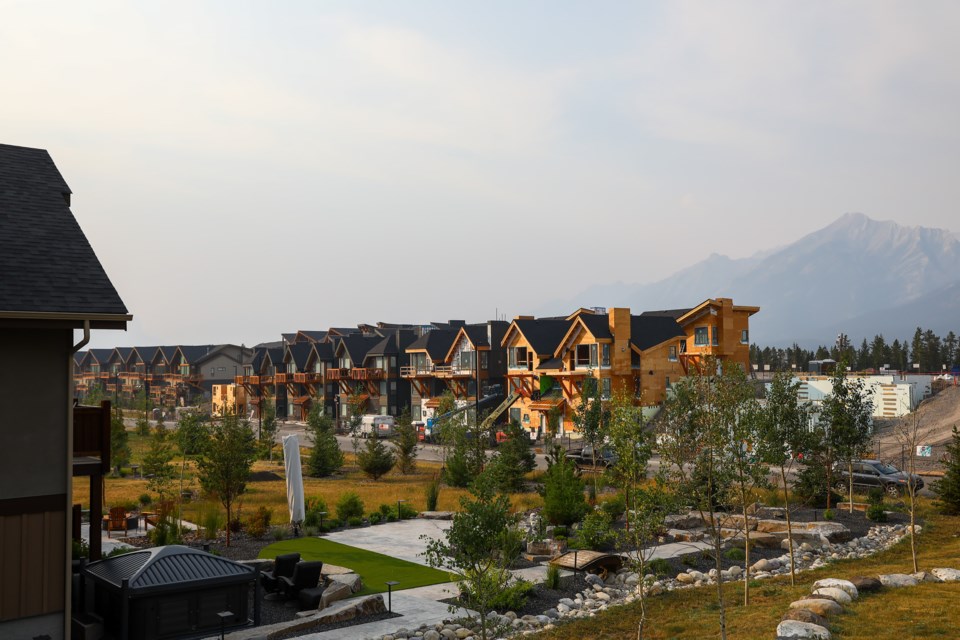CALGARY – The Town of Canmore is seeking permission to appeal the Land and Property Rights Tribunal's decisions on nine proposed grounds to receive the chance to formally appeal.
In its Aug. 29 filing, the Town provided its memorandum of argument for permission to appeal with the Court of Appeal hearing in early October.
The 76-page document raises issues such as the retrospectivity of the Land and Property Rights Tribunal (LPRT) having the jurisdiction to decide on the matter, that the Smith Creek and Three Sisters Village area structure plans (ASP) were not amendments as required by the 1992 Natural Resources Conservation Board (NRCB) decision and challenging the consistency of the ASPs with the NRCB approval.
It also argues there were inconsistent elements to the plans such as affordable housing and phasing of development, and that the LPRT failed to give enough reasons for issuing its order that the Town adopt the ASPs.
“An appeal has a reasonable chance of success if it is arguable, and a question of law is arguable if it is not frivolous,” the Town’s memorandum states.
A central argument for the Town is whether the LPRT had the jurisdiction to hear the matter in the first place. The Town claims the LPRT erred in giving itself jurisdiction to hear appeals from TSMVPL.
The tribunal hearings lasted 15 days and had more than 110 hours of testimony in addition to thousands of pages of evidence. On the first day of the hearings, the LPRT heard from both TSMVPL and the Town if it had jurisdiction, which it ruled it did.
“Clarification on who has jurisdiction to hear these appeals is similarly critical to avoid duplicity of proceedings and procedural certainty,” the memorandum states.
It claimed the LPRT failed to show the retrospective nature of Section 619 of the (Municipal Government Act) MGA and that it doesn’t apply to the ASP approvals, especially since Section 619 was added to the MGA in 1995 and after the 1992 NRCB approval. It adds Section 7 of the NRCB approval continues to give planning authority to the Town.
Town of Canmore memorandum for permission to appeal Land and Property Rights Tribunal's decisionofCanmorev2... by Greg on Scribd
“The prejudicial consequence of Section 619 on the Town (and its residents) is limiting local autonomy and the ability of council and planning authorities to make decisions in the best interests of residents,” according to the Town’s memorandum. “The impact of Section 619 may benefit TSMVPL, but it prejudices the Town.”
The Town further argues the LPRT failed to properly interpret the consistency of the ASPs in relation to Section 619 and the 1992 NRCB decisions, which was a central argument during the tribunal hearings. It states what the NRCB approved was a recreation and tourism program, while what was ultimately proposed was a “predominantly residential development,” according to the Town’s argument.
“The ASPs provide for development well outside of what was considered by the NRCB,” the memorandum states.
The Town adds the LPRT failed to give “adequate reasons” for its decisions as dictated under the MGA and “the failure to provide proper, adequate and intelligible reasons will result in the decision being set aside.”
The Town is asking for direction if council is bound by the 1992 NRCB approval. It also highlighted if council was actually required to adopt the two ASPs, as directed by the LPRT, due to Section 619 of the MGA.
“This issue is important not only from the perspective of the parties, but also from the perspective of all developers and municipalities where development approval is required at both the provincial level and the municipal level,” the permission to appeal states.
Under Section 688 of the MGA, an appeal must raise a question of law or jurisdiction, question the law or jurisdiction sufficiently to warrant an appeal and have a reasonable chance for success.
The Court of Appeal allowed the NRCB and Stoney Nakoda First Nation to be intervenors at the leave to appeal hearing, while it denied Bow Valley Engage.
The Stoney Nakoda are only permitted to intervene on four specific subparagraphs of the LPRT decisions, while the NRCB received the status to help with potential questions of its 1992 decision. The two parties have been involved in discussions on the lands since the 1991 NRCB hearings.
Canmore council went in camera during its Tuesday (Sept. 6) meeting to discuss matters related to the ongoing litigation as the Town seeks permission to appeal the LPRT decisions. It was the eighth time this year council has gone in camera to discuss ongoing TSMVPL litigation.
At its 2022 budget, council set aside $750,000 for litigation with TSMVPL. The Town spent $217,000 during the LPRT hearings.
TSMVPL also has a $161 million lawsuit against the Town and previous council, while Thunderstone Quarries has a $63.5 million lawsuit against the Town since it owns lands that are part of the Smith Creek proposal.
The Court of Appeal's permission to appeal will be heard the first week of October.




